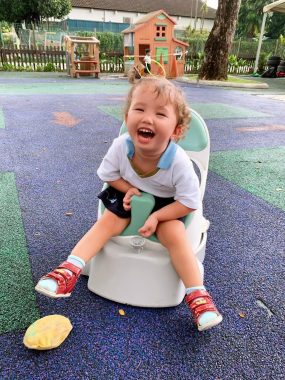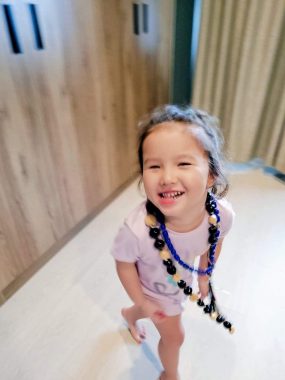How We’re Making Gradual Progress With Laughter Therapy
Parental instincts combine with science to help a columnist's daughter
Written by |

Once we finally knew what our daughter, Rylae-Ann, had, we also learned that genetically, she wouldn’t be able to move. She would most likely be bedridden, and there was no treatment. However, when she laughed, her body moved, her eyes opened, and I caught a glimpse of my daughter, who was trapped inside.
At 8 months old, Rylae-Ann was diagnosed with aromatic l-amino acid decarboxylase (AADC) deficiency. Although we finally had a correct diagnosis, we also were faced with the reality that there was no approved treatment at the time. The cold, hard facts did not slow our determination, however.
Movement with laughter
All parents want their children to be happy and smiling, and we’re no different. But our daughter had a genetic disease that made movement nearly impossible. Even summoning her muscles to smile or open her eyes was a noticeably taxing task. We observed that she seemed to come alive when she had a deep laugh.
Although these movements were involuntary and thus different from her conscious, controlled movements, it was still movement to us. It seemed like there was a neural pathway present, and if we strengthened it, maybe it would result in her having more controlled movements. Even if it resulted in a 1% improvement, we’d do it. We approached everything this way, hoping that it all would add up to signification improvement.

Although Rylae-Ann couldn’t move before gene therapy, we still worked on encouraging movement through laughter. (Courtesy of Richard E. Poulin III)
Dopamine and happiness
One of the first things a parent of a child with AADC deficiency learns about the rare disease is that the symptoms result from the body’s inability to synthesize dopamine. When I discovered this, I immediately thought of dopamine as the happiness chemical of our body. Later, I learned that it’s responsible for several vital functions, as well.
Dopamine is responsible for happiness, or more specifically, allowing you to feel pleasure, satisfaction, and motivation. But this vital neurotransmitter is also responsible for several crucial functions, including learning, movement, motor control, emotion, and executive function.
Our daughter did have some dopamine, but not much. So again, it seemed that if we helped to exercise that area of the brain by teaching it to produce dopamine, it might make a 1% difference. She would train her brain to produce dopamine and possibly make slight improvements through laughter.
Of course, this was just the wishful thinking of a desperate parent … but was it?

During a break in music therapy, Rylae-Ann runs around laughing, improving the results of therapy and reducing anxiety. (Courtesy of Richard E. Poulin III)
The medicine of laughter
Enter gelotology, the scientific study of laughter and its effects on the body. Research in gelotology has found that laughter does in fact provide physical and psychological benefits to the body. For those in the AADC deficiency community, some of the beneficial effects include:
- It induces relaxation, resulting in better sleep and fewer oculogyric crises
- It boosts the immune system, helping people stay out of the hospital and strengthening the body’s infection-fighting antibodies.
- It releases endorphins, which helps to relieve pain and promote a sense of well-being.
- It protects the heart by improving the cardiovascular system and helping to reduce heart problems.
Knowledge gained through gelotology has resulted in the creation of different therapies, including humor and laughter therapy, laughter meditation, and laughter yoga. All of these therapies aim to heal the mind and body through laughter, and combining it with other therapies may result in improved gains while we wait for gene therapy or future cures.
When we began consciously trying to boost our daughter’s laughter throughout the day, we also saw improved happiness and decreased depression. I like to believe our laughing therapies helped make a difference, albeit a slight one. But the slight improvements add up over time. So grab your little one and spend some time just laughing — it’s an instant journey to happiness.

Today, Rylae-Ann is noticeably happy and seems to always have a smile on her face, which puts a smile on our faces, too. (Courtesy of Richard E. Poulin III)
Note: AADC News is strictly a news and information website about the disease. It does not provide medical advice, diagnosis, or treatment. This content is not intended to be a substitute for professional medical advice, diagnosis, or treatment. Always seek the advice of your physician or other qualified health provider with any questions you may have regarding a medical condition. Never disregard professional medical advice or delay in seeking it because of something you have read on this website. The opinions expressed in this column are not those of AADC News or its parent company, Bionews, and are intended to spark discussion about issues pertaining to aromatic l-amino acid decarboxylase deficiency.





Leave a comment
Fill in the required fields to post. Your email address will not be published.